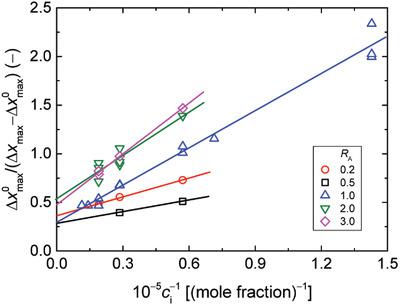当前位置:
X-MOL 学术
›
Cryst. Res. Technol.
›
论文详情
Our official English website, www.x-mol.net, welcomes your feedback! (Note: you will need to create a separate account there.)
Effect of Fe(III) Impurity on the Antisolvent Crystallization of Aqueous Ammonium Dihydrogen Phosphate Solutions
Crystal Research and Technology ( IF 1.5 ) Pub Date : 2020-02-03 , DOI: 10.1002/crat.201900213 Ewa Mielniczek-Brzóska 1 , Keshra Sangwal 2 , Jarosław Borc 2
Crystal Research and Technology ( IF 1.5 ) Pub Date : 2020-02-03 , DOI: 10.1002/crat.201900213 Ewa Mielniczek-Brzóska 1 , Keshra Sangwal 2 , Jarosław Borc 2
Affiliation

|
Experimental results of a study of the effect of FeCl3 impurity on the antisolvent crystallization of ammonium dihydrogen phosphate, involving processes of formation of 3D nuclei and growth of these nuclei, from its aqueous solutions saturated at 30 °C and containing different impurity concentrations ci from in situ measurements of temperatures of saturated solutions and pure water as functions of feeding time t of antisolvent ethanol at predefined rates RA are described and discussed. The processes of formation of 3D nuclei and growth of these nuclei are studied in terms of the maximum antisolvent content ΔxmaxN and ΔxmaxG, determined from intervals of temperature difference (Ts−Tw) = ΔT < 0 and ΔT > 0, respectively, obtained from measurements of temperature Ts and Tw of saturated solution, without and with impurity, and pure water. It is found that: 1) the processes of 3D nucleation in antisolvent crystallization from solutions containing impurities can be explained in the framework of theoretical expressions such as a Nývlt‐like relation and an approach based on 3D‐nucleation theory, and 2) adsorption of impurity particles accounts for the increase in the values of antisolvent contents ΔxmaxN and ΔxmaxG of solutions during 3D nucleation and growth of crystallites.
中文翻译:

Fe(III)杂质对磷酸二氢铵水溶液反溶剂结晶的影响
研究FeCl 3杂质对磷酸二氢铵反溶剂结晶的影响的实验结果,涉及3D核的形成过程和这些核的生长过程,这些过程由其在30°C饱和且含有不同杂质浓度c i的水溶液形成描述并讨论了根据饱和溶液和纯水的温度的原位测量,以预定速度R A注入抗溶剂乙醇的时间t的函数。形成三维核的和这些核生长的处理进行了研究,最大反溶剂含量Δ方面X MAXN和Δ X maxG分别由温差(T s - T w)= ΔT <0和ΔT > 0的间隔确定,分别是通过测量饱和溶液的温度T s和T w来获得的,该温度在无杂质和有杂质以及纯净水的情况下。发现:1)从含杂质的溶液中反溶剂结晶的3D成核过程可以在理论表达式的框架内进行解释,例如Nývlt关系和基于3D成核理论的方法,以及2)吸附杂质颗粒占在反溶剂含量的值的增加Δ X MAXN和Δx在微晶3D成核和生长过程中的溶液的maxG。
更新日期:2020-02-03
中文翻译:

Fe(III)杂质对磷酸二氢铵水溶液反溶剂结晶的影响
研究FeCl 3杂质对磷酸二氢铵反溶剂结晶的影响的实验结果,涉及3D核的形成过程和这些核的生长过程,这些过程由其在30°C饱和且含有不同杂质浓度c i的水溶液形成描述并讨论了根据饱和溶液和纯水的温度的原位测量,以预定速度R A注入抗溶剂乙醇的时间t的函数。形成三维核的和这些核生长的处理进行了研究,最大反溶剂含量Δ方面X MAXN和Δ X maxG分别由温差(T s - T w)= ΔT <0和ΔT > 0的间隔确定,分别是通过测量饱和溶液的温度T s和T w来获得的,该温度在无杂质和有杂质以及纯净水的情况下。发现:1)从含杂质的溶液中反溶剂结晶的3D成核过程可以在理论表达式的框架内进行解释,例如Nývlt关系和基于3D成核理论的方法,以及2)吸附杂质颗粒占在反溶剂含量的值的增加Δ X MAXN和Δx在微晶3D成核和生长过程中的溶液的maxG。



























 京公网安备 11010802027423号
京公网安备 11010802027423号